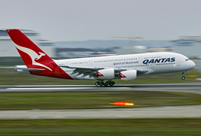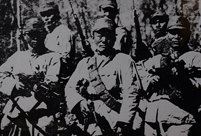 Ballerinas anywhere but onstage
Ballerinas anywhere but onstage
 Top 10 safest airlines in the world
Top 10 safest airlines in the world
 Top 10 most popular instant messaging apps in the world
Top 10 most popular instant messaging apps in the world
 Inspiring shadow images of Chinese army
Inspiring shadow images of Chinese army
 Models shine Xinjiang auto show
Models shine Xinjiang auto show
 From laid-off worker to int'l referee in bodybuilding
From laid-off worker to int'l referee in bodybuilding
 Selected photos of 'two sessions'
Selected photos of 'two sessions'
 Most unusual taxis around the world
Most unusual taxis around the world
 Bridge Worship Festival in Taijiang, SW China
Bridge Worship Festival in Taijiang, SW China
CANBERRA, March 28 -- Aircraft crews reported first sightings of objects floating in the southern Indian Ocean after the Australian authorities moved the search for Malaysia Airlines flight MH370 to a whole new area Friday.
The shift was the result of a credible new lead that Australian Prime Minister Tony Abbott vowed would be thoroughly investigated.
The new search area, at 319,000 square km, is about four times bigger than the previous search area in the southern Indian Ocean and 1,100 km to the northeast, according to the Australian Maritime Safety Bureau (AMSA).
It was also just 1,850 km due west of Perth, meaning it was in more moderate seas and closer to the search base so aircraft could spend longer over the area, AMSA and Australian Transport Safety Bureau (ATSB) officials said at a joint press conference in Canberra.
The crew of a New Zealand air force P3 Orion reported seeing objects floating in the water late Friday, although they could not be confirmed by ship until Saturday, according to the AMSA Twitter feed.
Earlier Friday, AMSA emergency response general manage John Young said that an international air crash investigation team in Malaysia had provided updated advice that had refined the presumed flight path and determined the new area.
"This is our best estimate of the area in which the aircraft has likely crashed into the ocean," said Young.
The key pieces of information related to early positional information from the aircraft the aircraft's "pinging" and later tracking by a satellite of the aircraft system, said ATSB chief commissioner Martin Dolan.
This analysis was combined with data from Boeing about the likely performance, such as speed and fuel consumption, of the Boeing 777 aircraft.
"The new information is based on continuing analysis of radar data between the South China Sea and the Strait of Malacca before radar contact was lost," said Dolan.
"It indicated the plane was travelling faster than previously estimated, resulting in increased fuel usage and reducing the possible distance it travelled south into the Indian Ocean."
Young said the new search area had two benefits, with the first being its closer proximity to Perth.
"We will certainly get better time on the scene. We started nearly 3,000 km from Perth," said Young.
"The other benefit we get from being further north is the search area has moved out of the Roaring Forties, which creates very adverse weather. I'm not sure that we'll get perfect weather out there, but it's likely to be better more often than we've seen in the past and we will see what that does it terms of satellite imagery when the retasking of satellites starts to produce new material as well."
Under the international convention relation to air accident investigations, searchers would have to hand over any wreckage retrieved to Australian authorities, he said.
"Any wreckage that is obtained we will hold on behalf of the Malaysian investigation team and await their instructions," said Dolan.
Prime Minister Tony Abbott said in a statement to Parliament that his government would continue to work closely with the Malaysian and Chinese governments on the search, which had been "a truly remarkable international effort."
"This is an extraordinarily difficult search, and an agonising wait for family and friends of the passengers and crew," said Abbott.
"As I have said from the start, we owe it to them to follow every credible lead and to keep the public informed of significant new developments. That is what we are doing," he said.
Ten aircraft had been tasked for Friday's search: two Royal Australian Air Force (RAAF) P3 Orions, a Japanese Coast Guard Gulfstream 5 jet, a Japanese P3 Orion, a P3 Orion and a C130 Hercules from the Republic of Korea, a New Zealand air force P3 Orion, a Chinese People's Liberation Army Air Force Ilyushin IL- 76, a United States Navy P8 Poseidon aircraft, and one Australian civil jet acting as a communications relay.
Six ships were relocating to the new search area including HMAS Success and five Chinese ships.
Chinese Maritime Safety Administration (MSA) patrol ship, Haixun 01, is in the search area.
Australian navy ship HMAS Success was expected to arrive in the search area late Saturday night.
A U.S. towed pinger locator and Bluefin-21 Autonomous Underwater Vehicle have arrived in Perth to assist with location and recovery of the black box flight data and cockpit voice recorders.
The depth of the water in the search area was between 2,000 and 4,000 meters.
 Female journalists at 'two sessions'
Female journalists at 'two sessions' Interpreters serving 'two sessions'
Interpreters serving 'two sessions' Female SWAT team in Chongqing
Female SWAT team in Chongqing Top 10 safest airlines in the world
Top 10 safest airlines in the world Old photos of Anti-Japanese War
Old photos of Anti-Japanese War Mysterious 'Dolan Tribe' in Xinjiang
Mysterious 'Dolan Tribe' in Xinjiang A bite of Luoping County
A bite of Luoping County This is Shanghai
This is Shanghai Chinese airborne troops complete parachute training in various training bases
Chinese airborne troops complete parachute training in various training bases Ballerinas anywhere but onstage
Ballerinas anywhere but onstage Most unusual taxis around the world
Most unusual taxis around the world Micro-expression at 'two sessions'
Micro-expression at 'two sessions' Bridge Worship Festival in Taijiang, SW China
Bridge Worship Festival in Taijiang, SW China Hollywood documentary brings Diaoyu Islands truth to new audience
Hollywood documentary brings Diaoyu Islands truth to new audience Miss HK and actresses shine at flower show
Miss HK and actresses shine at flower showDay|Week|Month